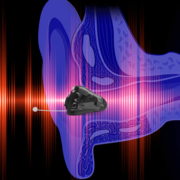Hearing Tech Roundup: 4 Gadgets We’re Giddy About
We’re always on the lookout for ways to meet your needs even better than we already do. These days, the world of technology seems to most often fit the bill. And we’re excited about these boundary-pushing devices that provide effortless, clear connection.
ReSound ONE
“Breakthrough” and “groundbreaking” are tossed around a lot these days. Especially when talking technology. The ReSound ONE, though, earns its accolades and then some.
Today’s hearing aids help a lot. In fact, they’re amazing mini-supercomputers. But the microphones sit just outside or behind your ear — not in your ear canal — so your hearing isn’t as natural.
Until now. This one-of-a-kind hearing aid uses an extra microphone inside your ear canal. With your ear’s unique shape, it collects and funnels sound organically – as only your ear can. You hear the way you’re used to hearing.
With this technological breakthrough, only available in the ReSound ONE, you can:
- Hear effortlessly anywhere, even grocery stores and windy walks
- Stay connected no matter what on video calls with family and providers
- Enjoy a sound ecosystem using wireless streaming accessories
- Recharge-and-go hearing aids last all day on one charge
Contact us to learn more about this groundbreaking organic hearing solution.
ReSound Key
ReSound Key features technology that allows your hearing aids to work together more efficiently, so you can focus on the sounds you want without losing touch with the sounds around you. And, with a full family of hearing aid models, there is a solution for virtually every lifestyle, preference, and budget.
With ReSound Key, you can also look forward to:
- Hearing sounds clearly with less effort
- Access to rechargeable hearing aid technology – no more tiny batteries
- Direct streaming from compatible mobile devices
- One easy-to-use app to individualize your sound experience
- Optional wireless accessories to extend your hearing in any environment
- Access to remote hearing care from the comfort and safety of your home
Whichever model you choose, ReSound always gives you a natural, individualized, and premium hearing experience, intuitively adapting to you and the environments in which you spend your time.
Oticon More
Oticon just introduced a brand-new hearing device that gives the brain more of what it needs to make better sense of sound, so you can get more out of life.
Oticon More hearing devices were developed to work more like how your brain works — they learn through experience. This is because Oticon More has the world’s first Deep Neural Network embedded on the chip.
As a result, Oticon More:
- Delivers more sound to the brain
- Increases speech understanding
- Reduces listening effort so that you remember more of what is being said
With these devices, you can easily connect to your TV and catch a sporting event, show, or movie with your friends and family again. Plus, it’s powered by a rechargeable battery that lasts all day so you can talk on the phone or listen to music with confidence that your hearing device will keep up with you, even on the busiest days.
OrCam Hear
Recently OrCam, a company that develops assistive devices, showed off the OrCam Hear at CES 2021 in Las Vegas. So far they’ve focused on products for vision and dyslexia that use artificial intelligence and machine learning. Now they’ve entered the hearing space.
OrCam is a small wireless device that drapes around your neck on a string, and you pair it to your Bluetooth-enabled hearing aids. It lip-reads and analyzes body gestures to determine which person you’re trying to hear, isolates their voice, and streams their speech to your hearing aids. It intuitively switches when it determines there’s a new speaker.
It comes out later this year, and a price isn’t determined yet. You can sign up to receive updates about the product launch.




